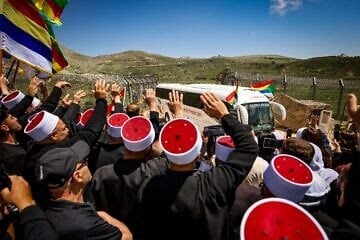More than 500 residents of Syria were allowed by their country’s new rulers and Jerusalem to join a pilgrimage in the Galilee.
Canaan Lidor
(JNS)
For the first time in decades, hundreds of Druze Syrians visited Israel on Friday for a religious celebration that one participant described to JNS as evidence of a “fundamental change in the reality of life in the region.”
About 500 Druze from Syria, as well as some from Jordan, joined Israeli Druze citizens for the annual celebrations at the tomb of Nabi Shu’ayb (known in English as Jethro’s tomb), the holiest site for the Druze religion, which is situated near the village of Hittin, three miles west of Tiberias in the Galilee.
“It was a moving event that heralds a reality shift in the region,” Nabi Halabi said. Halabi, a renewable energy specialist who lives in the Druze town of Majdal Shams on the Golan Heights, told JNS about the event, which he attended.
The visit was authorized by Ahmed al-Shara, the former Al-Qaeda leader whose forces rule much of Syria after they brought down the regime of Bashar Assad in December, Halabi said. Under Assad, crossing into Israel would have carried severe penalties. This reality kept families, including Halabi’s, separated for decades.

But the new regime in Syria is sending “signals of wanting some degree of normalization, and this historic visit is part of that,” Halabi, 57, said. On the geopolitical level, “it means a watershed moment is approaching. But for so many families, this is a moving moment of reunification.”
In Syria, “there’s no demand being put forward, as it was before, that Israel give back the Golan as a precondition to peace; it’s been dropped from the agenda,” continued Halabi.
He reads this as meaning “one of two things: Either Syria has accepted a reality where the Golan is Israeli, or that it seeks to lease it to Israel symbolically for 100 years or some such arrangement. Either way, this gives hope for the future,” he said.
The Golan Heights’ Druze community, numbering around 20,000, came under Israeli control during the Six-Day War in 1967. Since then, their political identity has been shaped by a complex balancing act: While most declined Israeli citizenship and maintained loyalty to Syria, largely out of fear that Israel might return the Golan to the Assad regime, they simultaneously built deep social and economic ties within Israeli society.
Younger generations in particular have increasingly integrated, mastered Hebrew and participated actively in Israeli life. Events such as the Syrian civil war and the Assad regime’s collapse accelerated this trend, with growing numbers embracing Israeli citizenship and expressing dual identities—culturally Druze and Syrian, but increasingly Israeli in civic life.
The Druze in the rest of Israel, who number about 150,000 people, are fully integrated, with high rates of enlistment into Israel Defense Forces combat units. They maintain close familial and cultural ties with Druze communities in the Golan.
Israel’s control of the Golan Heights has been a point of strategic necessity and diplomatic controversy. The Knesset extended Israeli law to the territory in 1981, a move not internationally recognized until the U.S. acknowledged in 2019 that the Heights are part of Israel.
For decades, Israeli leaders feared that peace negotiations might require returning the Golan to Syria, until the prospect was rendered unlikely due to the Syrian civil war and the rise of Sunni Islamists in the country.
Following the Assad regime’s collapse, Israel captured additional territory on the Syrian side of the Golan for security reasons.
Image: Druze from Syria enter Israel for a pilgrimage to the tomb of of Nabi Shu’ayb through Majdal Shams on April 25, 2025. Photo by Jamal Awad/Flash90.


